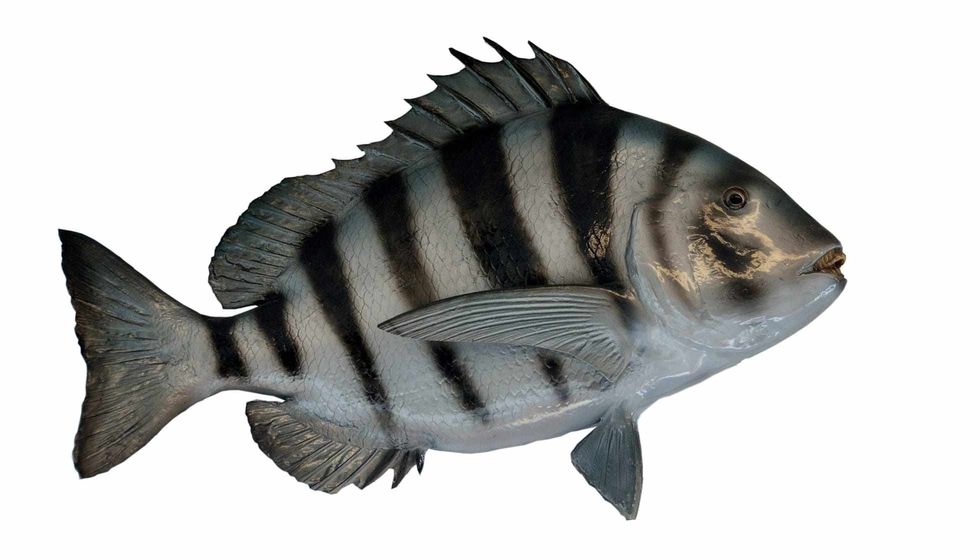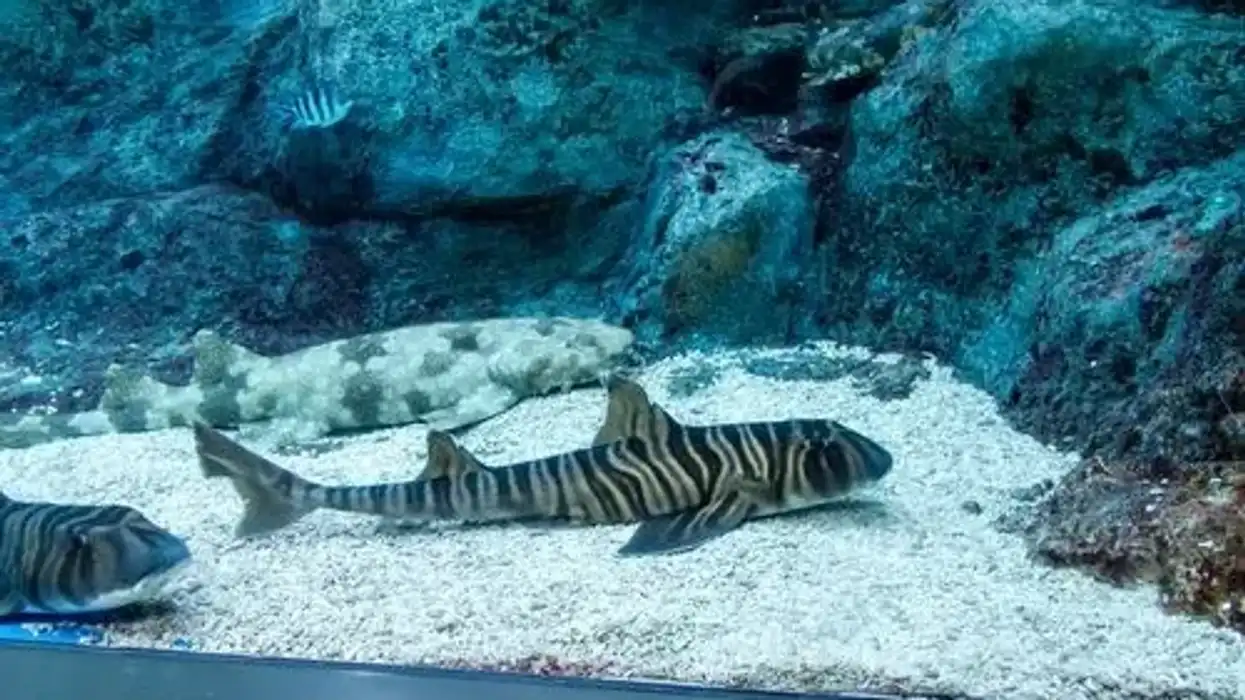Sheepshead (Archosargus probatocephalus) is a kind of fish found in the coastal waters in the Western Atlantic and the Gulf of Mexico, with a dense population in southwest Florida. In Central and South America their population is not that widespread, but it can be found in the southern tip of Brazil.
They can also live in brackish waters. The yellowfin bream is a related fish to the sheepshead, belonging to the same family.
These fish have a silvery or greenish-yellow body with vertical markings which are very prominent in the young fish. They have eerily human-like teeth and their molar teeth are set in their upper and lower jaws.
They also have spines on their anal and dorsal fins. Sheepshead fish have an omnivorous diet and feed on plant matter and several kinds of vertebrates and invertebrates.
The flesh of sheepshead fish is a very popular food choice for people. They are caught in large numbers on the coast of Florida.
The best time to catch these fish is during March and April when they gather to spawn. In the Gulf of Mexico, these fish are caught for both commercial and recreational purposes.
To learn more about this unique fish, keep reading! You can also check out swai fish facts and brown trout facts.
Sheepshead Interesting Facts
What type of animal is a sheepshead?
Sheepshead is a kind of fish. This fish is also known as the convict fish due to the five or six dark vertical bars that are present on its body.
What class of animal does a sheepshead belong to?
Sheepshead fish belong to the class Actinopterygii. They are a part of the order Perciformes.
How many sheepsheads are there in the world?
The exact population of sheepsheads (Archosargus probatocephalus) is not known. However, their population is not severely fragmented and has been marked as being Stable by the International Union for Conservation of Nature, or IUCN. In Florida, the population of these fish has increased over the last few years.
Where does a sheepshead live?
The distribution of sheepshead fish includes the Western Atlantic, the Gulf of Mexico, and the Central and South American coasts. Their population ranges from Nova Scotia in the North to Brazil in the South. The densest distribution of these fish is found in southwest Florida. In Central and South American coasts the population is not that prominent.
What is a sheepshead's habitat?
Sheepshead fish are most commonly seen inshore around rock pilings, jetties, mangrove roots, piers, and tidal creeks. These fish also like brackish waters.
During the winter and early spring, this species can be seen swimming to the offshore areas. They carry out their spawning in such regions, which include artificial reefs. The young juveniles belonging to this species live on the mud bottoms.
Who does sheepshead live with?
The sheepshead fish can be seen in crowds around rock pilings, jetties, and piers. The juvenile sheepsheads are known to start living with the adults once they attain a body length of 2 in (50 mm). These fish are also seen in public aquariums where they can co-exist with other species of fish.
How long does a sheepshead live?
The lifespan of a sheepshead fish has been recorded to be around 20 years.
How do they reproduce?
Adult sheepshead fish are known to travel offshore during winter and early spring for spawning. The spawning events occur most commonly during February, March, and April.
Some of the fish of this species are capable of spawning when they attain the age of two. However, for most sheepshead fish the spawning age is three for males and four for females.
Each spawning season is characterized by more than one spawning event which takes place in the offshore habitat near the coast. The females are known to produce 1100-250000 eggs which hatch after 28 hours following successful external fertilization.
What is their conservation status?
The conservation status of the sheepshead fish (Archosargus probatocephalus) has been marked as of Least Concern by the International Union for Conservation of Nature. However, they are most commonly threatened by activities like fishing and harvesting.
Sheepshead Fun Facts
What do sheepsheads look like?

The appearance of the sheepshead fish is unlike most other fishes. They have a deep, compressed, and oval body shape which is silvery to greenish-yellow in color, along with five or six deep vertical bars on both sides of their body. These vertical markings have earned them the nickname 'convict fish'.
The snout is small and blunt in these fish. Their anal and dorsal fins have sharp spines and appear black. The second anal spine is quite enlarged.
Their pectoral fins are pretty long and green-toned. This fish is particularly known for its dental arrangement. They have very prominent incisors, grinders, and molars in their mouth.
Their molars are arranged in a specific way with three rows in the upper jaw and two rows in the lower jaw. They are said to have a hard mouth. These human-like teeth help the fish to crush their shelled prey.
How cute are they?
Sheepshead fish are not cute, but the appearance of this fish can be considered to be unique. Their human-like teeth in their mouth with well-defined molars and incisors, along with the sharp spines on their body give them a distinct look.
How do they communicate?
The exact methods of communication in sheepsheads are not known. In general, fish are capable of communicating through visual and chemical methods.
How big is a sheepshead?
The length of an adult sheepshead is most commonly between 14-18 in (35.5-45.7 cm). Some sheepshead fish can grow as big as 30 in (76 cm). Sheepsheads are bigger in length than the related yellowfin bream fish, which belong to the same family Sparidae.
How fast can a sheepshead swim?
The exact speed of swimming is not known for these fishes. The adult sheepshead fish displays grazing behavior and swims near inshore docks and jetties while feeding. The larvae become better swimmers as they grow older and hence, are capable of feeding themselves easily.
How much does a sheepshead weigh?
Generally, the weight range of a sheepshead fish is 1-8 lb (0.4-3.6 kg). However, they can weigh as much as 22 lb (10 kg).
What are the male and female names of the species?
There are no distinct names for male or female sheepshead fish.
What would you call a baby sheepshead?
Baby sheepshead fish are known as larvae or juveniles.
What do they eat?
Sheepshead fish have an omnivorous diet. The bigger juveniles and adult sheepsheads can easily prey on smaller vertebrates and invertebrates like clams, crustaceans, small fish, and blue crabs with the help of their strong teeth. They also eat plant material. The larvae are known to have a diet consisting of zooplankton and polychaetes.
Are they dangerous?
These fish are not known to be dangerous or poisonous. However, they do have sharp spines on their body and very strong teeth and hence, they should be handled carefully if caught.
Would they make a good pet?
The sheepshead fish is not a very common pet fish species. However, it can be possible to keep them as pets, if all their requirements are fulfilled. These fish are also kept in public aquariums and can be viewed up close quite easily.
Did you know...
This fish is known as sheepshead due to the arrangement of its teeth, which resembles the teeth of sheep. Another reason could also be the appearance of their silhouettes.
Sheepsheads do not respond well to low oxygen levels in the water. They are not tolerant of fluctuating oxygen levels and need a steady supply of oxygen to survive.
Microcotyle archosargi is parasitic on the sheepshead fish.
Sheepshead fish are often confused with black drum fish due to their very similar appearance. However, the black drums do not have teeth like sheepshead fish.
The growth is pretty rapid in these fishes until they are between six and eight years old, but once they cross that age, the growth rate also slows down, especially in males.
What is the best bait to use for sheepshead?
The best bait used for sheepshead fish are mussels, shrimps, sand fleas, and fiddler crabs. These fish are known to feed on crustaceans and invertebrates.
Fishing methods like trawlers and bottom longlines are used to catch this species. These fish can be quite difficult to catch as their human-like teeth allow them to bite off the bait and steal it.
Hence, it is best to use a small hook while fishing for this kind. Florida is particularly notable for having a wide population of sheepshead fish which results in significant success in fishing for them.
What eats sheepshead fish?
The sheepshead fish has a few common predators that prey on them. These include sharks and other larger fish. Additionally, humans are also known to eat sheepshead fish. It has a very mild flavor and white flesh which makes it suitable for human consumption. Hence, they are caught quite frequently.
Here at Kidadl, we have carefully created lots of interesting family-friendly animal facts for everyone to discover! Learn more about some other fish including the Pacific salmon and the herring.
You can even occupy yourself at home by coloring in one of our free printable sheepshead coloring pages.










